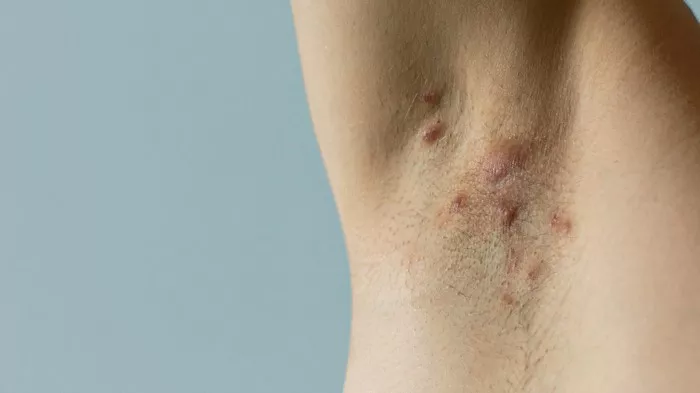Hidradenitis Suppurativa (HS) is a chronic, inflammatory skin condition characterized by painful nodules, abscesses, and sinus tracts in areas rich in apocrine glands, such as the axillae, groin, and perianal region. Despite its prevalence and impact on quality of life, misconceptions persist regarding its etiology, particularly the erroneous belief that HS is a result of poor hygiene. In this article, we will explore the scientific evidence debunking this myth and shed light on the complex pathophysiology of HS.
The notion that HS is caused by inadequate hygiene stems from a misunderstanding of its presentation and triggers. The disease typically manifests in areas prone to friction and sweating, leading some to attribute its development to uncleanliness. However, research has elucidated a multifactorial pathogenesis involving genetic predisposition, immune dysregulation, and environmental factors.
Genetic Predisposition
Numerous studies have identified a strong genetic component in the development of HS. Familial clustering and twin studies have demonstrated a higher concordance rate among monozygotic twins compared to dizygotic twins, indicating a significant hereditary influence. Mutations in genes involved in the regulation of innate and adaptive immunity, such as the gamma-secretase complex and the folliculin gene (FLCN), have been implicated in HS pathogenesis. These genetic abnormalities disrupt normal immune function and predispose individuals to inflammatory skin reactions, irrespective of hygiene practices.
Immune Dysregulation
HS is characterized by dysregulated immune responses within the skin, leading to chronic inflammation and the formation of abscesses and sinus tracts. Research has highlighted the role of aberrant innate and adaptive immune pathways in perpetuating the disease process. Dysfunctional follicular epithelium, coupled with alterations in the composition of the skin microbiome, creates an environment conducive to inflammation and bacterial colonization.
Moreover, cytokine dysregulation, particularly increased levels of tumor necrosis factor-alpha (TNF-α) and interleukin-1 beta (IL-1β), further contribute to tissue damage and disease progression. These immunological abnormalities are independent of hygiene practices and underscore the systemic nature of HS.
Environmental Factors
While hygiene may influence the severity of HS symptoms, it does not serve as a causative factor. Environmental triggers, such as obesity, smoking, and hormonal fluctuations, play a significant role in exacerbating disease activity. Obesity, in particular, is strongly associated with HS development and progression. Adipose tissue produces proinflammatory cytokines and adipokines, exacerbating local inflammation and perpetuating the disease cycle.
Smoking has also been implicated as a risk factor for HS, with studies demonstrating a dose-dependent relationship between cigarette consumption and disease severity. Nicotine and other constituents of tobacco smoke exert immunomodulatory effects, impairing host defenses and promoting chronic inflammation.
Dispelling the Myth
Contrary to popular belief, HS is not a result of poor hygiene. While maintaining good personal hygiene is important for overall skin health, it is not a preventive measure against HS development. The disease’s pathogenesis is multifaceted, involving genetic predisposition, immune dysregulation, and environmental triggers.
Misattributing HS to poor hygiene perpetuates stigma and can delay diagnosis and appropriate management. Healthcare providers must educate patients and the general public about the true nature of HS to dispel misconceptions and promote understanding. By fostering awareness and empathy, we can support individuals living with HS and work towards improved outcomes and quality of life.
Conclusion
Hidradenitis Suppurativa is a chronic, inflammatory skin condition characterized by painful nodules, abscesses, and sinus tracts. Despite its prevalence, misconceptions persist regarding its etiology, particularly the belief that HS is caused by poor hygiene. However, scientific evidence has debunked this myth, highlighting the complex interplay of genetic predisposition, immune dysregulation, and environmental factors in HS pathogenesis.
Dispelling the myth of poor hygiene as a cause of HS is essential for promoting understanding and reducing stigma associated with the condition. By educating patients and the public about the true nature of HS, healthcare providers can foster empathy and support for individuals living with this debilitating disease. Moving forward, continued research and advocacy efforts are needed to improve diagnosis, management, and quality of life for those affected by HS.
Related Topics:
Is Hidradenitis Suppurativa a Skin Disease?


























